As in the past, the ARC’s national groundnut cultivar evaluation trials were planted during 2021/2022, amidst difficult climatic conditions. Dryland and irrigated trials were planted at the major groundnut production areas to cover different climatic conditions. The trials at Potchefstroom and Vaalwater could not be harvested due to excessive rain.
The results that will be shown here are from irrigated trails (Bultfontein and Vaalharts) and dryland trails (Bothaville, Setlagole, Hoopstad). Two trials (dryland and irrigated) were planted at Setlagole, but only one set of data from that locality will be shared. Because of the high rainfall received in that area, the irrigated trial did not materialise. Both trials were rainfed to a maximum level.
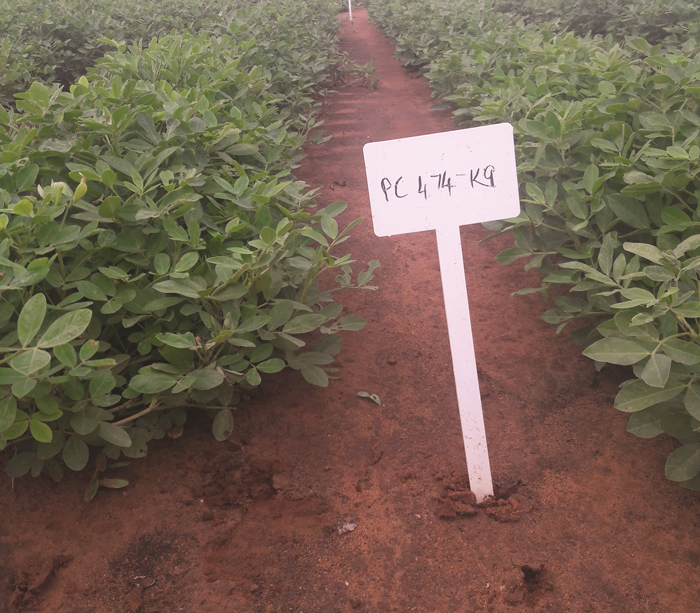
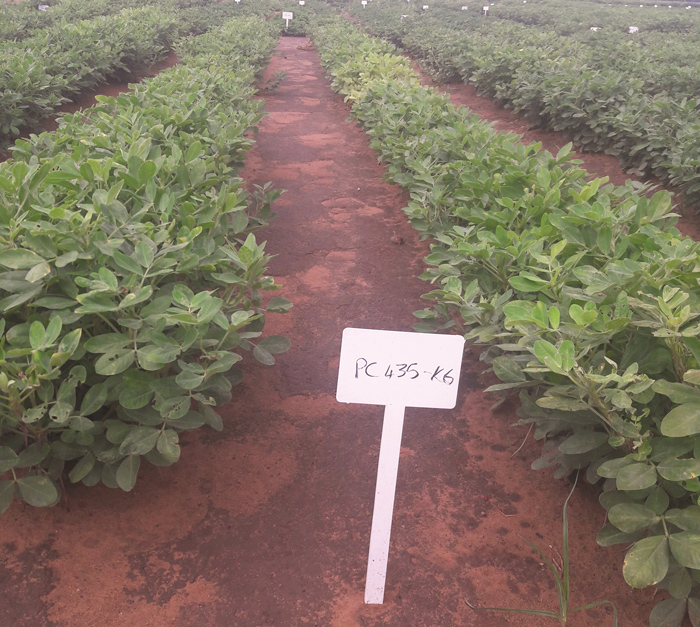
Research method and results
Data of the two dryland trials (Hoopstad and Bothaville) could be recorded and analysed. The trials were planted according to the randomised block design and were statistically analysed by using a GENSTAT programme. The inter-row spacing was 90 cm and the intra-row spacing was 8 cm. Only the data of importance covering the Choice Grade (60/70 and 70/80) groundnut gradings are shown in Table 1 to Table 4. The rest of the grading data are available from snijmanw@arc.agric.za. The figures in red represent the genotypes (breeding lines and cultivars) that produced the best yield per locality.
Table 1 indicates that in the dryland trials, Bothaville had ten genotypes that yielded a higher pod mass above the grand mean of 4,62 kg and Hoopstad had nine genotypes higher than the grand mean of 8,31 kg. The best cultivar at Bothaville was SelliePlus with 5,89 kg and at Hoopstad it was GP023 with 9,5 kg. As would generally be accepted in regard to irrigated crops, the irrigation trails did not produce much higher yields compared to the dryland trails because of the high precipitation levels that were recorded during 2021/2022.
Vaalharts had the highest pod mass (5,57 kg) that was produced by ARC Opal and eleven genotypes did better than the Vaalharts grand mean (4,75 kg). The other irrigated locality was Bultfontein, where the newly registered cultivar ARC474 (from breeding line PC474-K9) did the best; the pod mass was 4,87 kg and eleven genotypes did better than the grand mean of 4,75 kg. The pod mass at Setlagole was 3,2 kg.
The kernel mass was determined by shelling a 500 g pod sample per genotype and per repetition, which was then weighed. In Table 2 it was indicated that Hoopstad outperformed all the localities. The kernel mass of the Kwarts sample was 403,7 g and nine genotypes performed better than the grand mean of 370,2 g. The best performer at Bothaville was ARC Opal with 373,6 g and ten genotypes were better than the grand mean of 354,1 g. The kernel mass values from the irrigation trials were again not better. The kernel mass at Vaalharts was 390,6 g (Anel) and at Bultfontein 380 g (ARC Opal).
Table 3 shows that in the dryland trials, Hoopstad had the highest number of genotypes (ten) that produced better than the grand mean (31,7 g) on sieve nine, and the highest mass of the kernels on sieve nine was 64,4 g. Bothaville had nine genotypes above the grand mean of 10,79 g with the best genotype (GP023) that produced 19,63 g of kernels. Under irrigation, Vaalharts had the highest number of values (ten) above the grand mean (7,29 g) of the sieve nine kernel mass. Although Vaalharts performed better regarding the number of genotypes above the grand mean (7,29 g), Bultfontein produced the highest yield of 23,13 g by PC435-K6, which is also one of the newly registered cultivars.
Table 4 represents the size and mass of the groundnuts measured by sieve 8,25 and it is also part of the Choice Grade groundnut grading. Bultfontein outperformed the genotypes under both dryland and irrigation conditions. Under dryland conditions at Bothaville and Hoopstad, the best performer was PC481-K3 (65,1 g) at Hoopstad.
At Bothaville the best performer was AkwaPlus with 60,7 g. Both Bothaville and Hoopstad had ten genotypes that performed better than the respective grand means. Vaalharts had the highest number of values (ten) on sieve 8,25 above the Vaalharts grand mean mass (39,5 g). However, Bultfontein produced the highest mass of 71,1 g by PC 472-K3. Setlagole also had ten genotypes performing better than the grand mean of 29,9 g. The best performer at Setlagole was PC435-K6 (registered as ARCK6 as new cultivar).
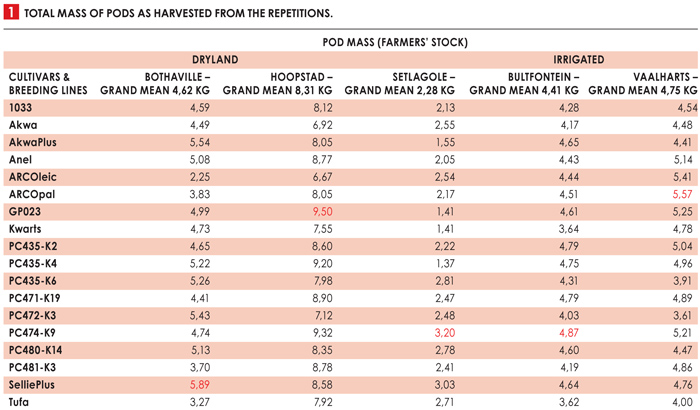
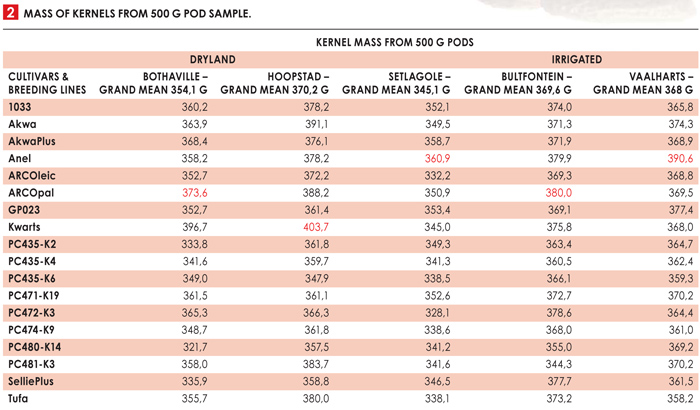
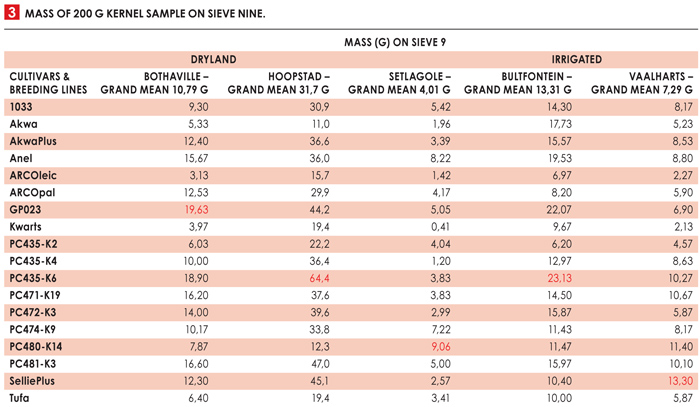
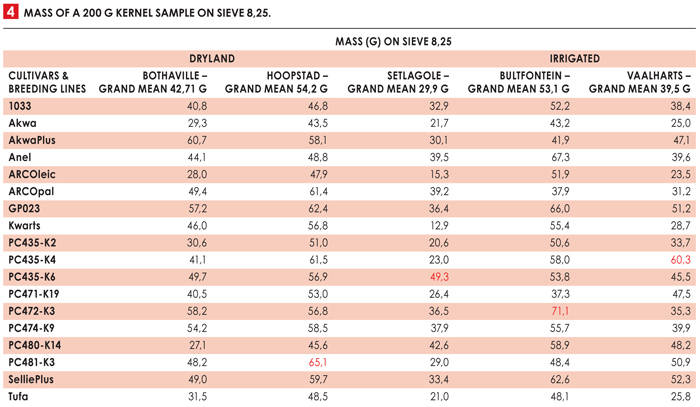 Conclusion
Conclusion
Erratic weather patterns disrupted the trials to a huge extent – this was indicated by the variations in the data within a locality and amongst localities. However, the trials are a useful tool to study the performances of the different breeding lines and existing cultivars.
 Due to the ongoing trials, the ARC managed to identify two breeding lines that were registered as new cultivars in September 2022. The seed of the two new lines (ARC474 and ARCK6) will be multiplied during the 2022/2023 season and as soon as enough seed is available, the industry can obtain the seed from ARC-Grain Crops. During the 2021/2022 season, other breeding lines (those with a PC number) also showed promise.
Due to the ongoing trials, the ARC managed to identify two breeding lines that were registered as new cultivars in September 2022. The seed of the two new lines (ARC474 and ARCK6) will be multiplied during the 2022/2023 season and as soon as enough seed is available, the industry can obtain the seed from ARC-Grain Crops. During the 2021/2022 season, other breeding lines (those with a PC number) also showed promise.



























